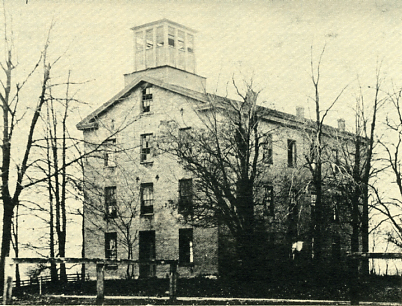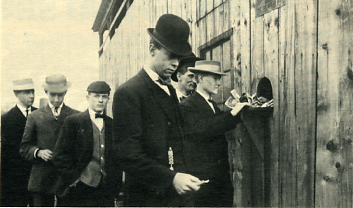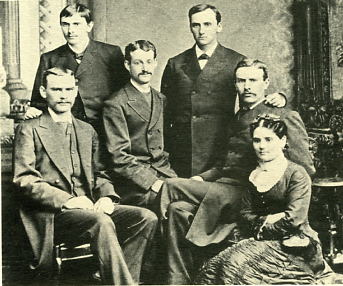
Old College in Northwood, Ohio
Click Here to Return to Milestones
Geneva College was founded almost 150 years ago, not in Beaver Falls, but in a small village in Ohio, west of Columbus, named Northwood.
Northwood was located in Logan County near the highest point in the state of Ohio, at the headwaters of three rivers, the Miami, which flows south through Dayton to join the Ohio west of Cincinnati; of the Scioto, which flows southeast through Columbus to the Ohio; and of the Maumee, which flows north to Toledo and Lake Erie.
Northwood sat on the Greenville Treaty Line, which from 1795 to 1818 divided white territory from Indian lands. Even after 1818, when the Indians ceded their remaining lands in Ohio, they retained reservations, including the well-known Indian village of Solomon's Town, a stone's throw from Northwood. Simon Kenton, a famous white scout, had many adventures in the area, but loved it and spent his last years in the neighborhood.

The College stood at one end of Northwood's main street, on a rise of ground overlooking a brook that is a source of the Miami River. At the other end, three blocks away, sat a large building built originally as a Female Seimnary, but which after the college became coeducational served as the home of the president and the dormitory for women students. The town was proud of the college, grateful for the intellectual and spiritual tone it provided for the community, and in the early 1870s changed its name to West Geneva in its honor.
Admittedly the students of the college were a mixed blessing. Notes of college news from the local newspaper included such items as the following:
Those boys who used H. H. George's horse all night without leave might study with profit to themselves that scripture which saith, "The merciful man is merciful to the beast. "
Some of the students were a little high, last Wednesday night. Certain young men got so high in the Seminary (building) that they could not get down without detection.
But the townspeople found the village very quiet when the students were gone for vacation.
Like most of the many colleges founded in the early nineteenth century, Geneva's first years were difficult. It led a precarious financial existence for its first quarter century, until H. H. George became president in 1872. Earlier presidents of the college had seen themselves as teachers first of all. It was their job to teach, and to teach well, whatever students came (and to try to subsist on the tuition money they provided). Dr. George was the first "modern" president, who not only taught, and taught well, but also saw the life and prosperity of Geneva as his responsibility, publicizing the college, looking for students and for financial support.
Though President George was almost a native son of Northwood, he seems to have quickly reached the conclusion that the Northwood community could not provide the pool of students or the financial support that were necessary if the college was to become a stable institution. The college had begun as a local venture, founded under the Lakes Presbytery of the Reformed Presbyterian Church. It was soon officially taken over by the Synod of that demoination, but it had difficulty changing its image from that of a local college to one that would win the support of the denomination as a whole. Soon after Dr. George became president there began to be talk of moving the college. In the spring of 1875, several leading citizens of Belleforitaine, the county seat, talked of inviting the college to move "into town." They noted that the college would be "an honor to our place ... and bring from $15,000 to $25,000 into our place every year." The citizens of the town proposed to raise $30,000 to erect a building, if the Synod would provide an endowment of $50,000. This proposal was presented to the Synod at its meeting in May, 1875. After some discussion, which the minutes do not describe, the motion was passed that:
Synod is not prepared to entertain the proposition ofthe removal ofthe college from Northwood
Grateful for this action, the Northwood community raised $2,000 (a tidy sum for those days) for renovation of the college building, flagstone walks on both sides of the main street (the Northwood mud was frequently commented on), and the building of a "boarding house" for the students.
That same year, the college began a serious attempt to raise an endowment. By 1878, it was reported that "encouraging progress" had been made. In fact, about $23,000 had been pledged, but with some awkward strings attached! The subscriptions from the Northwood area were conditional on the college remaining there; those from other areas largely conditional on its moving. What does one do when confronted with such a dilemma? Appoint a committee!
The Synod of 1878 took the matter seriously and appointed a prestigious committee, which invited proposals from any interested communities. Some months passed without a response. It began to seem (as often happens) that the people who said they wanted change were not themselves prepared to take the leadership in making the change. At length, lacking other alternatives, the committee proposed to Northwood that if that community could raise $18,000 for a new building, they could keep the college. By May, the Northwood community had not quite met the goal; so the committee again asked for proposals. Eventually four communities made invitations: Northwood; Bellefontaine, again; Morning Sun, Iowa; and Beaver Falls. By a large majority the Synod chose Beaver Falls, and the selection was made unanimous. The Synod then appointed a committee to carry out the move.
It is hard to learn a century later what conversation and correspondence lay behind the Beaver Falls proposal and its adoption. We know that the Beaver Falls proposal had been put together rather at the last minute. We know that the key part of the proposal was the grant of ten acres of land by the Harmony Society, a prosperous German communal society located nearby along the Ohio River. But questions remain. How did the Harmony Society know that this little Ohio college was looking for a home? Who talked to whom about it? What motivated the decision?
Jacob Henrici, the trustee of the Harmony Society, kept the business dealings of the Society in his head; and the records of the Society make no mention of the transaction, much less of any of the details. Nor do the College records shed light on the decision.
It is obvious, of course, that it was a win-win situation. On one hand, the Harmony Society was in process of developing its new industrial town at the falls of the Beaver River, and a college would indeed add to the honor of the place, increase the value of its real estate, and bring the buying power of the faculty and students into the local coffers. Henrici could crown his town with a college on the hill. At the same time, the Synod seemed to want the college moved "east," and nearer larger centers of membership, not rural, but also not too urban. Beaver Falls seemed to fit that description. The local Reformed Presbyterian congregation had an energetic young pastor, Robert J. George; and it had several energetic entrepreneurs in the new town, one of whom, J. D. McAnlis, a well-known jeweler, was for many years a college trustee. The congregation would be augmented by both faculty and students. It seemed to benefit both college and community. But it would be interesting to know how it all came together.
Synod made its approval of the move to Beaver Falls conditional on receiving the ten-acre grant and on raising $20,000 for a building, with July 31, 1879, as the deadline for the decision. On that critical day the committee and other invited guests met. The report of the committee to the Synod describes what happened:
The early part of the day was spent in examining the proposed site for the college building. It was the judgement of all present that a more desirable location could scarcely be secured. The natural scenery is delightful. Hill and vale, river and forest, the peaceful quiet, broken for a few minutes hourly by the rush of the railroad train, combine to make a scene scarcely equaled.
The distance from the center of the town - about a mile and a quarter - was thought by some to be a disadvantage, but those who have walked twice as far many a day to school and college, will be disposed to make light of that Those who had not had such experience, and do not desire it, can ride on the train to the corner of the college grounds.
After dinner was served by ladies of the town, the committee organized for business. John Reeves, Esq., acting on behalf of the Harmony Society, appeared before the committee and formally offered them the agreedupon ten acres of ground, fulfilling the Synod's first requirement. The subscription for the building had reached only $17,600 of the required $20,000; but when that was announced the remainder was promptly subscribed. The brand-new Pittsburgh and Lake Erie Railroad, being built along the river, promised a stop at the foot of the hill and at the suggestion of the committee named it College Station. The die was cast. Geneva College would move to Beaver Falls.
The original ten-acre site was the northeast corner of the Braden farm, which the Harmony Society had bought in 1868 to provide room for the growth of the town. The college property was bounded on the east by the center of the P&LE track and on the west by the "public road from Beaver Falls to Homewood," now College Avenue. The deed reserved to the college two hundred feet or river bank on which to build boathouses along the river. The land would revert to the Society if a "suitable and proper" college building were not built and a college established "where in may be obtained a complete thorough and substantial education." In the meantime, the plot must not be broken up and sold for building lots.
To draw up plans for the "suitable and proper" building the committee selected a respectable Pittsburgh architect, James P. Bailey, whose later commissions included the Butler County courthouse and the First Presbyterian Church in Beaver. His design excited the committee. That same summer President George bought ground across the road and built a rather imposing residence, the Wylie House of more recent memory. Professor McCartney bought two acres just north of the college and built the house Mrs. McCartney named Fern Cliffe, which is still standing today.
During the summer of 1879, the building of Old Main began. The College was to stay in Northwood for one year until the building would be completed to occupy. The process, like many such ventures, was a discouraging one. All the usual things went wrong. Inflation drove the cost over budget. Eventually, what with this and that, the cost of the building was not $20,000, but $35,000, all of which had to be raised by subscription before the Synod would accept the deed. The contractor went bankrupt, stopping all construction. When the contracts were again opened for bids, the bids were much higher - and the committee began to act as its own general contractor, with William Pearce (the father of a later President, M. M. Pearce) as construction manager. When that happened, the committee had to pay cash for materials; and thus was dependent on a steady flow of contributions. The economy was improving, driving up wages and the cost of materials. The experimental hot air heating system was hopelessly inefficient and had to be replaced. In his final report to the Synod, the chairman understandably remarked, "We are free to say that such an undertaking would not have been entered upon if we had been able to see the end from the beginning." Happily, not seeing the future, they persevered. The college had an imposing building on a commanding site - more obvious now that the building is again visible as it was planned to be.

In the meantime, whether the building was ready or not, the students arrived for fall classes in September, 1880. This is considered the official moving date. Because the building on the hill was not yet finished, the students met for classes in the Reformed Presbyterian Church building on Main Street and boarded where they could. The Independent, a Beaver Falls newspaper, began in January, 1881, and almost at once bits of college news appeared in its pages:
The college boys don't appear to have spare time enough to get 'lonesome' this session.
An evening entertainment was presented by the students in February and was reviewed extensively and frankly by the editor: it was too long, too serious, and the piano should have been in tune.
The new game of baseball was just catching on. The game between the students and the file shop boys was quite interesting, and some good plays were made on both sides.

The senior class ... were hospitably entertained at President George's house on Tuesday evening. The party went up the river in boats to 'College Station.'
The first college commencement in Beaver Falls was held on May 26, 1881. It was a gala day. The factories in the town closed for the day; the Pittsburgh and Lake Erie ran excursion trains, including one from Pittsburgh bringing members of the Synod, which attended en-masse. The editor of the Independent noted that all sorts of vehicles, as well as men, women, and children on foot, might have been seen wending their way to the college. The band was playing and people scattered around in all directions were demolishing the contents of innumerable baskets.

Because the building was still not finished, a platform had been set up in a grove overlooking the river, with seats around it for the audience. After the picnic was over, the commencement exercises began. As usual in those days, the speaking at commencement was done by the graduates. Each of the six seniors presented an oration. R. M. Downie, later the founder of the Beaver Falls firm, Keystone Driller, spoke on "Reason," and the editor commented, "beautiful, logical, forcible, well-delivered." The one woman in the class, Ella Johnston, chose as her subject, "Woman." After the orations, the president addressed suitable remarks to the seniors and presented their diplomas. Appropriately the band played, "We Parted By the River Side."
Then came the formal dedication of the college building, with an eloquent address by Dr. James Renwick Willson Sloane, an early president of Geneva, by 1881 a seminary professor and president of the college Board of Trustees. Professor Sloane described the view:
This elevated plateau, a sufficient height
above the river, affords sufficient room for college purposes;
this shaded bluff is susceptible of being made ... a beautiful
miniature park; the river flowing below us, one of the most beautiful
of the affluents of the upper Ohio, not only a "thing of
beauty" in itself, but one in which the hearts of students
delight, as one of the youthful orators of the day has told us,
affording
abundant opportunity for practice in the healthy exercise of skating.
That magnificent wall of foliage on the other side of the stream,
to which the eye turns with ever increasing delight, requires
but some old castle perched upon one of its
cliffs to rival the finest scenery of the storied Rhine. "
Following down the stream we come to the enterprising young city
of Beaver Falls, sufficiently near to break the sense of isolation,
sufficiently remote to secure these academic shades against the
intrusion of the noise of its varied and increasing industries
...
After describing his aspirations for the college, Sloane concluded: Friends of the college and brethren of the Reformed Presbyterian Church, we meet today under the most favorable auspices, to dedicate this institution to sound learning, and to invoke upon its present and its future the blessing of the Covenant God of our Fathers.
That conclusion of his address was an appropriate
beginning for Geneva College in its new setting; and continues
to be both the commitment and the prayer of the college a century
and more later.